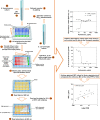Antimicrobial Sensitivity Assay for Bdellovibrio bacteriovorus
- PMID: 33659506
- PMCID: PMC7842378
- DOI: 10.21769/BioProtoc.3865
Antimicrobial Sensitivity Assay for Bdellovibrio bacteriovorus
Abstract
Bdellovibrio bacteriovorus, an obligate predatory bacterium [i.e., bacteria that kill and feed on other bacteria (prey)], has the potential to be used as a probiotic for the disinfection of surfaces or for the treatment of bacterial infections. One option is to use this organism in combination with antimicrobials to potentiate the effectiveness of treatments. In order to make this approach feasible more has to be known about the ability of B. bacteriovorus to resist antibiotics itself. Standard assays to determine the minimum inhibitory concentration (MIC) are not suitable for B. bacteriovorus, since the small size of this bacterium (0.25-0.35 by 0.5-2 μm) prevents scattering at OD600. Since these predatory bacteria require larger prey bacteria for growth (e.g., E. coli dimensions are 1 by 1-2 μm), the basis for the antimicrobial sensitivity assay described here is the reduction of the OD600 caused by prey lysis during growth. Previous studies on predatory bacteria resistance to antimicrobials employed methods that did not allow a direct comparison of antimicrobial resistance levels to those of other bacterial species. Here, we describe a procedure to determine B. bacteriovorus sensitivity to antimicrobials which can be compared to a reference organism tested as close as possible to the same experimental conditions. Briefly, minimal inhibitory concentration (MIC) values of B. bacteriovorus are determined by measuring the reduction in absorbance at 600 nm of mixed predator/prey cultures in presence and absence of different antimicrobial concentrations. Of note, this method can be modified to obtain antimicrobial MIC values of other predatory bacteria, using different conditions, prey bacteria and/or antimicrobials.
Keywords: Antibiotic; Bdellovibrio bacteriovorus; Broth dilution assay; MIC; Predatory bacteria.
Copyright © 2020 The Authors; exclusive licensee Bio-protocol LLC.
Conflict of interest statement
Competing interestsThe authors declare no competing interests.
Figures



References
-
- Lambert R. J. and Pearson J.(2000). Susceptibility testing: accurate and reproducible minimum inhibitory concentration(MIC) and non-inhibitory concentration(NIC) values. J Appl Microbiol 88(5): 784-790. - PubMed
-
- Lambert C. and Sockett R. E.(2008). Laboratory maintenance of Bdellovibrio . Curr Protoc Microbiol Chapter 7: Unit 7B 2. - PubMed
LinkOut - more resources
Full Text Sources

